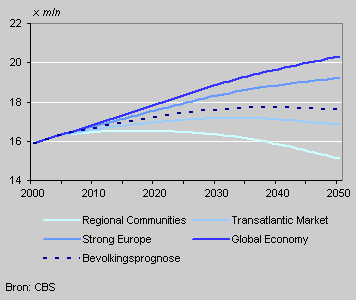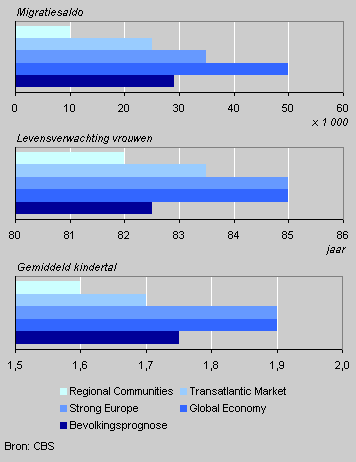Dutch population forecast scenarios

In 2050 the Netherlands will have 17.6 million inhabitants according to Statistics Netherlands’ population forecast, whereas at present the Dutch population totals 16.3 million. A faster or slower growth rate depends on economic growth and the direction in which the welfare state develops.
Several research institutes have made a joint effort to investigate how four different scenarios will affect population growth. The highest economic growth scenario predicts that the Dutch population will exceed 20 million in 2050.
Sweeping changes both in the Netherlands and Europe
The economic scenarios concerning the European Union result in four scenarios for the Dutch population.
- Global Economy assumes high economic growth and an austere welfare state. The population will grow rapidly to reach 20.3 million in the year 2050.
- Strong Europe combines care for the deprived with moderate economic growth. The population will grow relatively fast to reach 19.2 million in 2050.
- Transatlantic Market entails a large gap between the rich and the poor and the population will gradually grow to 16.8 million in 2050.
- Regional Communities; the present welfare state is upheld, economic growth is poor and the Dutch population will fall to 15.1 million in 2050.
Dutch population according to four different scenarios

Migration
In the Global Economy scenario, high economic growth will prompt many (immigrant) workers to come to the Netherlands. In the Transatlantic Market scenario this effect will be less prominent. The Strong Europe and Regional Communities scenarios are characterised by modest economic growth and a reduced influx of (immigrant) workers. But Strong Europe allows many immigrants to join their families and asylumseekers to enter the country.
Births
In the Global Economy and Strong Europe scenarios, the average woman is expected to have 1.9 children. According to the Strong Europe scenario childcare will be well-organised enabling women to combine children with a job. This will compensate for a lower standard of living.
The other scenarios anticipate a lower birth rate. In the Transatlantic Market scenario many couples have a low standard of living. Childcare is scarce. In the Regional Communities scenario low economic growth in combination with high unemployment will result in many couples choosing not to have children.
Net migration, female life expectancy and number of children, 2050

Mortality
In the Global Economy scenario strong economic growth and a healthy lifestyle go hand in hand. There will be breakthroughs in medical science will thrive, and the high standard of living will enable the population to pay for the soaring costs of health care. In the Strong Europe scenario prevention is a state priority and health care is cheap and accessible to everyone.
These scenarios anticipate a female life expectancy of 85 years.
The other scenarios are less optimistic. In the Transatlantic Market and Regional Communities scenarios substantial groups of deprived people have an unhealthy lifestyle. In the Regional Communities scenario health care chiefly aims at meeting basic needs.
Andries de Jong
Source: ‘‘Lange-termijn bevolkingsscenario’s voor Nederland’, De Jong (CBS) en Hilderink (RIVM) (Dutch only)